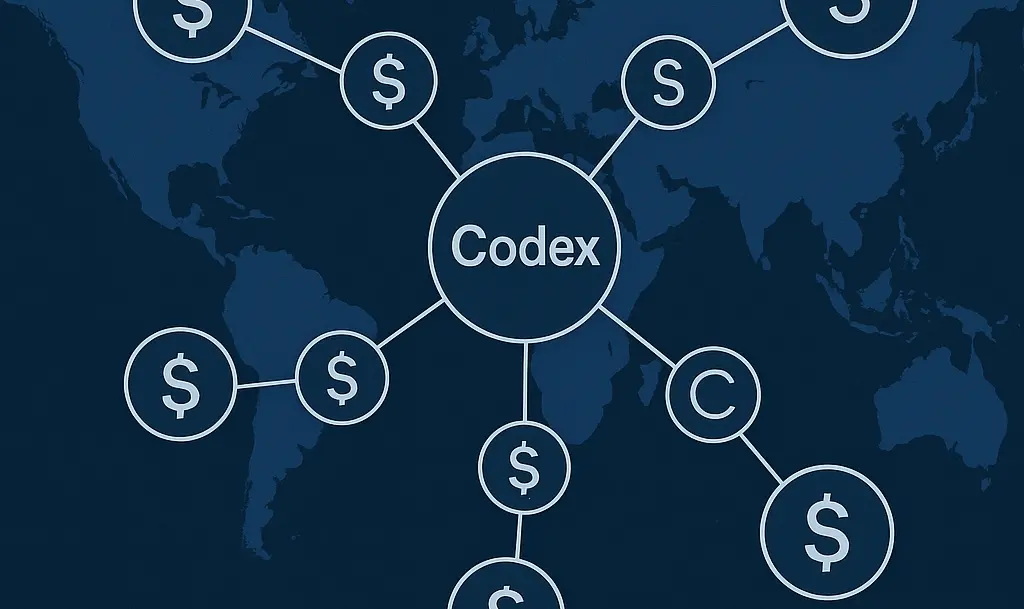Vertex: A rising star in the derivatives DEX, with a daily trading volume market share of about 10%
Original Author: duoduo, LD Capital
Original Source: medium
The competition in the derivatives DEX field is fierce, with leading players like GMX, DYDX, and SNX, and second-tier players like Gains, MUX, Level, and ApolloX, alongside a continuous influx of new protocols launching.
Vertex is a recently well-performing derivatives DEX protocol, which since its launch at the end of April 2023, has recently accounted for about 10% to 15% of the daily trading volume in the liquidity pool model derivatives DEX market, and received strategic investment from Wintermute in June 2023.
 Source: dune
Source: dune
Note: This chart does not include DYDX data and compares liquidity pool model derivatives DEXs.
1. Business Data
l Trading Volume: Mainly through trading incentives, it has created a high trading volume, with an average daily trading volume of about $40 million over the past 7 days. The purple part represents derivatives, while the yellow part represents spot, primarily focusing on derivatives trading.
The daily trading volume is lower than that of leading derivatives DEXs (DYDX/GMX/SNX), but comparable to that of second-tier derivatives DEXs. From the trading volume over the past 7 days, Vertex has already entered the top ten.
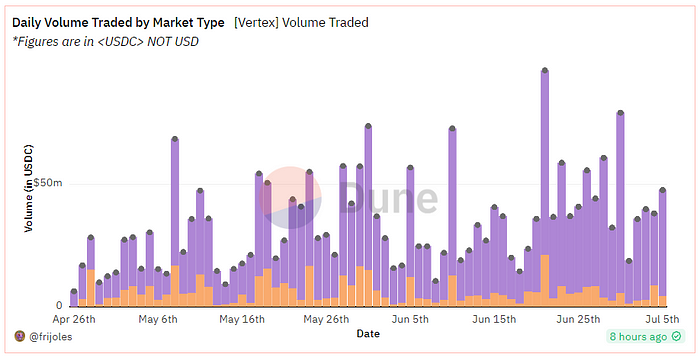 Source: dune
Source: dune
TVL: $6.22 million, still relatively small, including four types of tokens, as shown in the figure below:
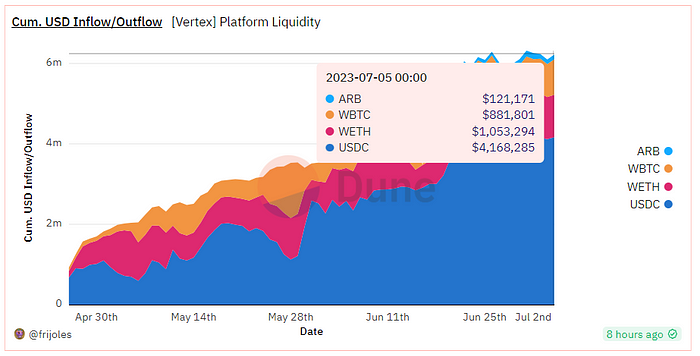 Source: dune
Source: dune
DAU: A total of 1,842 users, with about 200 daily active users over the past 7 days. In comparison, GMX has over 1,000 daily active users, DYDX around 700, and SNX about 500.
 Source: dune
Source: dune
Open Interest: There are a total of 7 trading pairs, with BTC and ETH occupying the main share, and the current open interest is about $5.37 million. The open interest amount is also relatively low.
DYDX's open interest is about $300 million, GMX's is between $150 million and $200 million, Gain Network is about $30 million to $50 million, and Mux is about $20 million to $50 million.
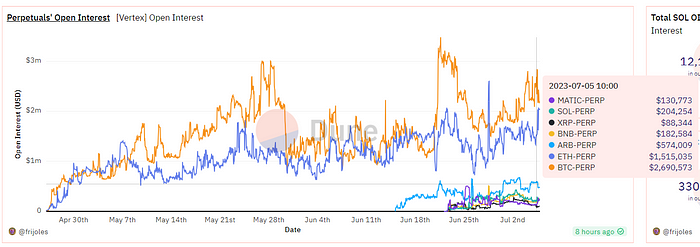 Source: dune
Source: dune
Fee: Cumulative gross revenue is about $540,000, with $86,000 deducted for maker rebates, resulting in a net income of $460,000.
 Source: dune
Source: dune
2. Team and Investors
Co-founder Darius, mainly responsible for external marketing activities.
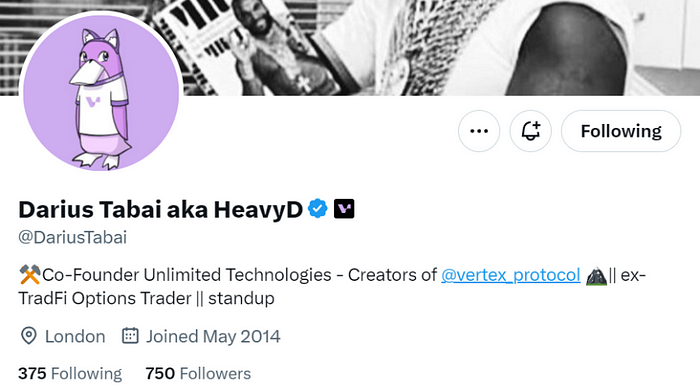 Co-founder Alwin Peng, previously worked at Jump Trading, is a blockchain engineer.
Co-founder Alwin Peng, previously worked at Jump Trading, is a blockchain engineer.
 Vertex received a strategic investment from Wintermute Ventures in June 2023. Wintermute Ventures is the venture capital arm of the cryptocurrency market maker Wintermute. Wintermute provides market-making services for several well-known projects such as Arb, OP, and Blur.
Vertex received a strategic investment from Wintermute Ventures in June 2023. Wintermute Ventures is the venture capital arm of the cryptocurrency market maker Wintermute. Wintermute provides market-making services for several well-known projects such as Arb, OP, and Blur.
When Wintermute announced its investment in Vertex, it stated: "Vertex is led by a strong team of traders and engineers with a solid track record in TradFi and DeFi markets, at the forefront of smart contract and market innovation."
Previously, in April 2022, Vertex raised $8.5 million in a seed round, led by Hack VC and Dexterity Capital, with follow-on investments from Collab+Currency, GSR, Jane St., Hudson River Trading, Huobi, JST Capital, Big Brain, and Lunatic Capital. Early investors received 8.5% of the tokens, meaning Vertex's seed round valuation was $100 million.
Vertex was originally a project built on Terra, and after the collapse of Terra, the protocol migrated to Arbitrum.
3. Product
Vertex provides a one-stop DeFi service, including spot, contracts, and lending markets, primarily focusing on the contract market, with most trades being perpetual contract trades, while spot and lending are more for servicing contracts, thus categorizing it as a derivatives DEX.
Liquidity Supply Model: Hybrid Order Book-AMM Model
The liquidity supply model is the main difference between Vertex and other derivatives DEXs. Vertex believes that off-chain order books can reduce MEV attacks and improve trade execution speed through FIFO (First In, First Out) processing. Meanwhile, on-chain AMM provides permissionless liquidity support, allowing traders to force trades and ensuring effective execution when order book liquidity is insufficient.
Vertex achieves the hybrid order book-AMM model through the following components:
On-chain trading venue (AMM);
On-chain risk engine for rapid liquidation;
Off-chain sorter for order matching.
Diagram: Vertex Core Component Architecture
 Source: Vertex
Source: Vertex
This means that in the Vertex trading platform, there are two types of liquidity: one provided by market makers through API order book liquidity, and the other provided by smart contracts as LP funds.
These two types of liquidity are combined through the sorter, and what is seen on the front end is a unified liquidity based on the best available price for trading. The following diagram shows how the sorter utilizes order book liquidity and LP liquidity to complete trades.
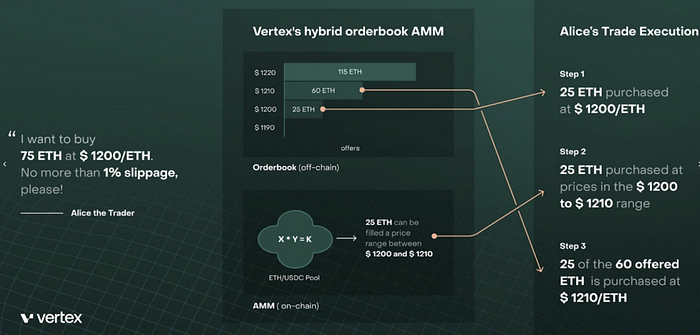 Source: Vertex
Source: Vertex
Process Analysis:
The trading price for the ETH-USDC pair is $1,200.
Alice wants to buy 75 ETH in the market and sets a maximum slippage of 1%.
There is an order on the order book for 25 ETH at a price of $1,200, so one-third of the trade is executed at $1,200.
The next set of sell orders on the order book (a total of 60 ETH) is at $1,210.
However, there are 25 ETH of LP positions priced between $1,200 and $1,210. Thus, the next one-third of the trade is purchased from the LP positions, with an execution price between $1,200 and $1,210.
The final one-third of the trade is executed at a price of $1,210.
Capital Efficiency: Universal Cross Margin Expands Margin Scope
Vertex aims to improve the efficiency of capital usage by proposing the concept of "Universal Cross Margin," which primarily expands the scope of margin.
Currently, there are two common margin models in derivatives trading. One is the isolated margin model (Isolated Margin), where each trading pair has a separate isolated account. Only the currency of that trading pair can be deposited, held, or borrowed in a specific isolated account. Each isolated account has an independent risk rate, calculated based on the assets and liabilities held under that trading pair. The risk is isolated within each isolated account, meaning that if a liquidation risk occurs, it does not affect other isolated accounts.
The other is the cross margin model (Cross Margin), where generally a user has only one cross margin account that can trade all supported currencies, with assets in the account cross-collateralized and shared; the risk rate is calculated based on all assets and liabilities under the cross margin account. Once a liquidation occurs, all assets in the account will be liquidated.
It can be seen that the capital usage efficiency of the cross margin model is higher than that of the isolated margin model. Based on this, Vertex proposes the Universal Cross Margin.
All funds (deposits, positions, and investment gains and losses) on the platform can be used as margin, including open positions in spot, perpetual contracts, and currency markets. For example, users providing liquidity for the spot pool can earn fees while this LP capital can also be used as margin for contract trading. This improves the efficiency of capital usage.
Universal Cross Margin also allows portfolio margining, where unrealized profits can be used to offset unrealized losses or serve as margin for existing positions or opening new positions.
To help users better manage their account risks, Vertex also provides account risk level prompts, allowing users to see their account's health status directly on the page.
Accounts can be divided into two states: Initial and Maintenance. In the Initial state, they can further be categorized into low, medium, and high risk based on the margin to liability ratio. The Maintenance state means that the initial margin usage exceeds 100%, and no new positions can be opened; users need to replenish margin as soon as possible, or they may face liquidation.
Due to Universal Cross Margin, liquidation is also in the cross margin model, and will be executed in the following order:
Orders are canceled, releasing order funds;
LP assets are released and sold;
Assets are liquidated (spot balance/contract position);
Liabilities are liquidated (borrowings).
If during the liquidation process, the account's initial health status recovers to above 0, the liquidation will stop.
 Source: Vertex
Source: Vertex
Lower Trading Fees
Vertex's trading fees are relatively low. For both spot and contracts, the maker fee is currently 0, while the taker fee ranges from 0.01% to 0.04%.
 Source: Vertex
Source: Vertex
To encourage maker trading, makers whose trading volume exceeds 0.25% of the total trading volume over a specific period (28 days, one epoch) can also receive rebates. The rebate ratios are as follows:
 Source: Vertex
Source: Vertex
Comparing several major derivatives DEX markets, GMX has higher trading fees, with both opening and closing fees at 0.1%; DYDX's trading fees range from 0.02% to 0.05%, decreasing with increased trading volume; Kwenta's trading fees range from 0.02% to 0.06%.
4. Token Economic Model
VRTX is the governance token of Vertex Protocol, with a total supply of 1 billion tokens, of which 90.08% will be distributed within 5 years.
The token distribution is shown in the figure below, with a total of 46% allocated for community incentives, including 9% for initial phase token incentives and 37% for ongoing incentives; 41% is allocated for the team, treasury, ecological fund, and future contributors; 8.5% is allocated to early investors; and another 4.5% is for liquidity. It is important to note that this distribution chart was disclosed in early June 2022 and does not include the Wintermute investment portion. Generally, it may be allocated from the treasury to new investors.
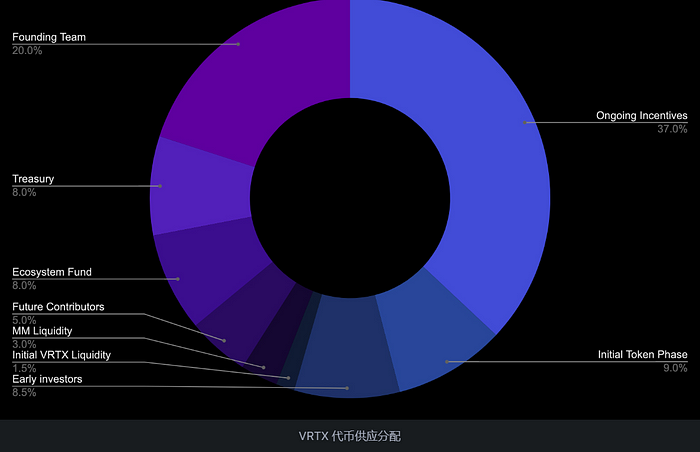 Source: Vertex
Source: Vertex
Vertex tokens will be distributed six months after the mainnet launch, which is expected to occur in October 2023. The token release schedule is as follows:
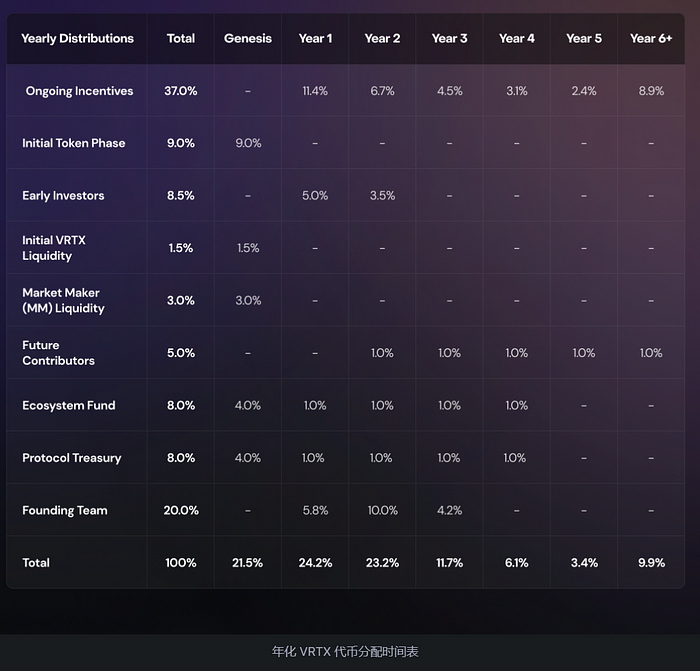 Source: Vertex
Source: Vertex
The Initial token phase allocates some tokens for trading incentives before the token issuance, and users can track this on the rewards page of the Vertex application, with the official website stating that the relevant incentives can be claimed in October 2023.
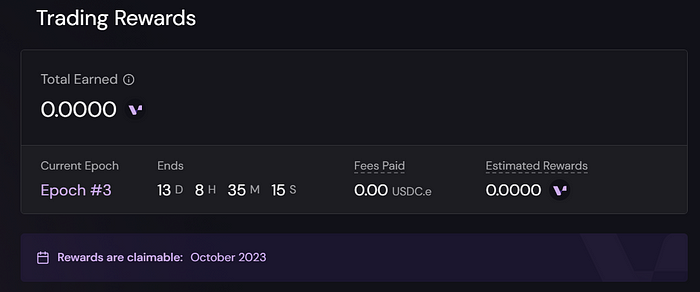 Source: Vertex
Source: Vertex
The Initial token phase consists of 6 epochs, each lasting 28 days, with each epoch rewarding 15 million tokens, and we are currently in the third epoch. The proportion of trading incentive tokens mainly considers the weight of trading fees. Additionally, different trading pairs have different rewards, as shown in the figure below:
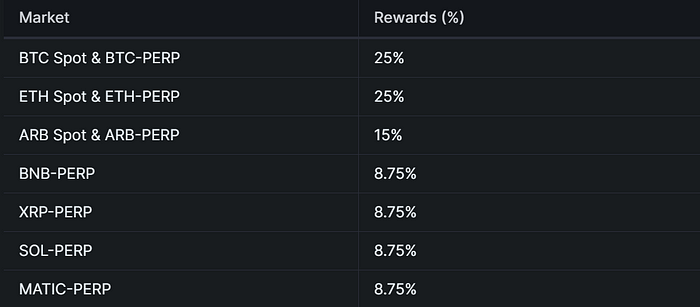 Source: Vertex
Source: Vertex
The Vertex protocol token has not yet been issued, and due to the existence of trading incentives, it is impossible to avoid wash trading behavior. Currently, the launch of derivatives DEX protocols relies on trading incentives, such as Vela, which implemented trading incentives in its beta version to stimulate trading volume growth. Most protocols maintain trading incentive measures after launch, such as DYDX and Kwenta. The current level of adoption for Vertex indicates a positive outlook for the protocol token.
5. Conclusion
The competition in the derivatives DEX space is already a red ocean. Many projects fork the GMX model, deploying on new public chains or layer twos, offering high APRs to attract funds and earn profits. In comparison, Vertex provides some innovative mechanisms aimed at creating better liquidity and higher capital efficiency, making it worth paying attention to.
The risk to note is that its Universal Cross Margin, while improving capital efficiency, also increases the risk exposure of user assets, requiring traders to implement appropriate risk controls.








